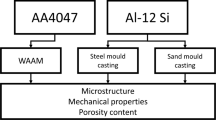Abstract
AlSi alloys with high Si content have good strength properties at elevated temperatures and resistance to thermal expansion. The main problem in the production of the classic methods of casting AlSi alloys with Si content above 20% is the formation of large precipitates of primary silicon. To prevent the formation of large precipitates of silicon can be used casting methods of rapid solidification and subsequent consolidation in the process of plastic forming. This paper presents the results of structure alloy AlSi30 cast in rapid solidification process on the wheel and consolidated in the process of extrusion and continuous rotary extrusion. The study was conducted on light microscopy and scanning electron microscope. It was found that the entire volume of the alloy is uniformly distributed fine Si particles.
Access this chapter
Tax calculation will be finalised at checkout
Purchases are for personal use only
Preview
Unable to display preview. Download preview PDF.
Similar content being viewed by others
References
L. Katgerman. F. Dom Rapidly solidified aluminium alloys by meltspinning Mat. Sc. Eng A375 – 377 (2004) pp 1212–1216.
Grant EP/E040608/1 Development of Bulk Nanostructured Aluminium Alloys for High Strength Applications. (University of Oxford) Ol. Juli 2007 – 31 December 2010.
B. Pucun “Microstructure and mechanical properties of a large billet of spray formed AlZnMgCu alloy with high Zn content Mat. Sc. Eng” 2009.
Frank Palm “Hypereutectic high Strength AlMgSc profile materials Melt- spun Scalmalloy- a new family of weldable and corrosion free Al alloys with 500 – 850 MPa strength” Aeromat 2006 15–18 th of May 2006. Seattle. Washington. USA.
A.J. Bosch, R. Senden, W. Etelmann, F. Palm. Nanostructured and High Strength Alloys: Scamalloy- a Unique High Strength and Corrosion Insensitive AlMgScZn Material Concept Aluminium Alloys Their Physical and Mechanical Properties Vol 1 Edited by Jürgen Hirsch Wiley- VCH 2008.
Feng Wang, Baiquing Xiong, Yongan Zhang, … “Microstructure and mechanical properties of spray-deposited Al-Zn-Mg-Cu alloy” Materials dand Design 28 (2007)1154–1158
Akihisa Inoue, Hisamichi Kimura “ Fabrication and mechanical properties of bulk amorphous, nanocry Staline, anaoquasicrystalline alloys in aluminium-based system” Journal of Light Metals 1 (2001) 31–41
P.M.Thomas Conform- the use of alternative feedstock materials APT Aluminium September 2004.
Author information
Authors and Affiliations
Editor information
Rights and permissions
Copyright information
© 2016 The Minerals, Metals & Materials Society
About this chapter
Cite this chapter
Szymański, W., Szymanek, M., Żelechowski, J., Bigaj, M., Gawlik, M., Płonka, B. (2016). Alloy ALSi30 Cast in the Process of Rapid Solidification and Consolidated in the Process of Plastic Forming. In: Sadler, B.A. (eds) Light Metals 2013. The Minerals, Metals & Materials Series. Springer, Cham. https://doi.org/10.1007/978-3-319-65136-1_58
Download citation
DOI: https://doi.org/10.1007/978-3-319-65136-1_58
Publisher Name: Springer, Cham
Print ISBN: 978-3-319-65135-4
Online ISBN: 978-3-319-65136-1
eBook Packages: Chemistry and Materials ScienceChemistry and Material Science (R0)




